
Atlanta is the capital and most populous city of the U.S. state of Georgia. With a 2020 census population of 498,715, it is the 38th most populous city in the United States. The city serves as the cultural and economic center of the Atlanta metropolitan area, home to more than six million people and the ninth-largest metropolitan area in the nation. Atlanta is the seat of Fulton County, the most populous county in Georgia. Situated among the foothills of the Appalachian Mountains, Atlanta features unique topography that includes rolling hills and the most dense urban tree coverage in the United States.
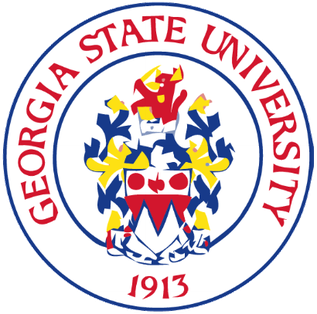
Georgia State University is a public research university in Atlanta, Georgia. Founded in 1913, it is one of the University System of Georgia's four research universities. It is also the largest institution of higher education by enrollment based in Georgia and is in the top 10 in the nation in number of students with a diverse majority-minority student population of around 54,000 students, including approximately 33,000 undergraduate and graduate students at the main campus downtown.
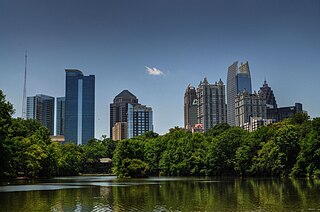
Midtown Atlanta, or Midtown, is a high-density commercial and residential neighborhood of Atlanta, Georgia. The exact geographical extent of the area is ill-defined due to differing definitions used by the city, residents, and local business groups. However, the commercial core of the area is anchored by a series of high-rise office buildings, condominiums, hotels, and high-end retail along Peachtree Street between North Avenue and 17th Street. Midtown, situated between Downtown to the south and Buckhead to the north, is the second-largest business district in Metro Atlanta. In 2011, Midtown had a resident population of 41,681 and a business population of 81,418.

The architecture of Atlanta is marked by a confluence of classical, modernist, post-modernist, and contemporary architectural styles. Due to the complete destruction of Atlanta by fire in 1864, the city's architecture retains no traces of its Antebellum past. Instead, Atlanta's status as a largely post-modern American city is reflected in its architecture, as the city has often been the earliest, if not the first, to showcase new architectural concepts. However, Atlanta's embrace of modernism has translated into an ambivalence toward architectural preservation, resulting in the destruction of architectural masterpieces, including the Commercial-style Equitable Building, the Beaux-Arts style Terminal Station, and the Classical Carnegie Library. The city's cultural icon, the Neo-Moorish Fox Theatre, would have met the same fate had it not been for a grassroots effort to save it in the mid-1970s.

Technology Square, commonly called Tech Square, is a multi-block neighborhood located in Midtown Atlanta, Georgia, United States. Tech Square is bounded by 8th Street on the north, 3rd Street on the south, West Peachtree Street to the east, and Williams Street to the west. Tech Square includes several academic buildings affiliated with Georgia Tech and provides access to the campus via the Fifth Street Pedestrian Plaza Bridge, reconstructed in 2007. It also contains restaurants, retail shops, condominiums, office buildings, and a hotel.
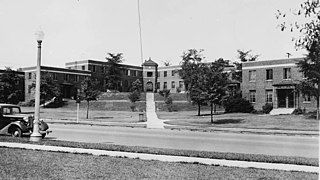
Techwood Homes was an early public housing project in the United States, opened just before the First Houses. Located in Atlanta, Georgia, it replaced an integrated settlement of low-income people known as Tanyard Bottom or Tech Flats. It was completed on August 15, 1936, but was dedicated on November 29 of the previous year by U.S. President Franklin D. Roosevelt. The new whites-only apartments included bathtubs and electric ranges in each unit, 189 of which had garages. Central laundry facilities, a kindergarten and a library were also provided. Techwood Homes was demolished in advance of the 1996 Olympics and is now Centennial Place Apartments.

DramaTech Theatre is Georgia Tech's student-run theater. They are also home to Let's Try This!.
The College of Design at the Georgia Institute of Technology, established in 1908 as the Department of Architecture and also formerly called the College of Architecture, offered the first four-year course of study in architecture in the Southern United States.

Dana Robins Ivey is an American actress. She is a five-time Tony Award nominee for her work on Broadway, and won the 1997 Drama Desk Award for Outstanding Featured Actress in a Play for her work in both Sex and Longing and The Last Night of Ballyhoo. Her film appearances include The Color Purple (1985), Dirty Rotten Scoundrels (1988), The Addams Family (1991), Home Alone 2: Lost in New York (1992), Addams Family Values (1993), Two Weeks Notice (2002), Rush Hour 3 (2007), and The Help (2011).
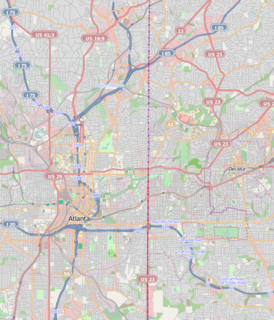
The Historic District of the Georgia Institute of Technology, also known as the Old Campus of Georgia Tech or the Hill District, is significant in the areas of architecture, education, engineering and science, as well as landscape architecture. The area is a Registered Historic Place and part of the central campus of Georgia Tech. Located in Midtown Atlanta, Georgia, United States, it is roughly bounded by North Avenue on the South, Bobby Dodd Stadium, a 55,000 seat football stadium on the East, Bobby Dodd Way on the North and Cherry Street on the West.

The Academy of Medicine in midtown Atlanta, Georgia was built in 1941 and housed the Medical Association of Atlanta until the 1970s. The building is listed on the National Register of Historic Places, and is also designated as a historic building by the City of Atlanta. It is currently owned by the Georgia Institute of Technology.

The Atlanta Biltmore Hotel and Biltmore Apartments is a historic building located in Atlanta, Georgia. The complex, originally consisting of a hotel and apartments, was developed by William Candler, son of Coca-Cola executive Asa Candler, with Holland Ball Judkins and John McEntee Bowman. The original hotel building was converted to an office building in 1999. The building is currently owned by the Georgia Institute of Technology and is adjacent to Technology Square.

The Georgia Institute of Technology, commonly referred to as Georgia Tech or, in the state of Georgia, as Tech, is a public research university and institute of technology in Atlanta, Georgia. It is part of the University System of Georgia and has satellite campuses in Savannah, Georgia; Metz, France; Athlone, Ireland; Shenzhen, China; and Singapore.

Emory Grove is a small area of bungalow style homes built in 1939 and the 1940s in Druid Hills, Georgia near Emory University. The Emory Grove Historic District, located between Emory University and the city of Decatur, Georgia, is a 90-acre (36 ha) historic district that was listed on the National Register of Historic Places in 2000.
Lullwater House is the president's mansion at Emory University near Atlanta, Georgia, overlooking Candler Lake. It was built in 1926 as the residence of Walter T. Candler, son of Coca-Cola founder Asa Griggs Candler. The mansion is in the form of an L, in Tudor-Gothic revival style. The architects were Ivey and Crook.

Rhodes Center was Atlanta's first shopping center. It was built in 1937 by architects Ivey and Crook and was one of the largest real estate developments in Atlanta during the Depression.
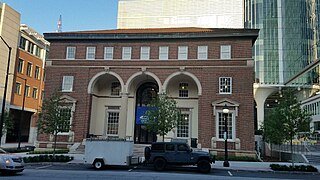
The Crum & Forster Building is a 1928 three-story building with a Renaissance façade with columns and arches located at 771 Spring Street at Tech Square in Midtown Atlanta.

The Olympia Building is a landmark at the absolute center of Atlanta, Five Points in Downtown Atlanta.

The main campus of the Georgia Institute of Technology occupies part of Midtown Atlanta, primarily bordered by 10th Street to the north, North Avenue to the south, and, with the exception of Tech Square, the Downtown Connector to the East, placing it well in sight of the Atlanta skyline. In 1996, the campus was the site of the athletes' village and a venue for a number of athletic events for the 1996 Summer Olympics. The construction of the Olympic Village, along with subsequent gentrification of the surrounding areas, significantly changed the campus.
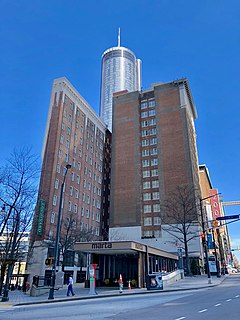
This article is about hotels in Atlanta, including a brief history of hotels in the city and a list of some notable hotels.




















